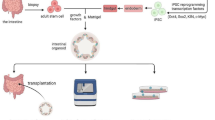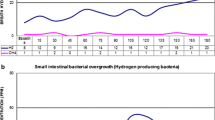Abstract.
Hypoxia has been implicated in the breakdown of the intestinal epithelial barrier in animals, leading to bacterial translocation (BT); however, the mechanism of this hypoxic insult is unknown. To determine the effects of hypoxic injury in vitro on epithelial membrane integrity, transepithelial electrical resistance (TEER), mannitol permeability (Ma-Pm), and BT were measured in both an adult (Caco-2) and fetal (I-407) intestinal epithelial cell culture model. Caco-2 adult and I-407 fetal epithelial cell monolayers were treated with or without bacteria (1×107 Escherichia coli. C-25), and then incubated under either normoxic (5% CO2 in room air) or hypoxic (5% CO2 and 95% N2) conditions at 37°C for 6 h. Hypoxia caused a 10% increase in Ma-Pm in the I-407 fetal cell model independent of the bacterial challenge. In contrast, a bacterial challenge in the Caco-2 adult model caused a 485% increase in Ma-Pm independent of hypoxia. Neither hypoxia, nor C-25 bacteria, for 6 h caused BT in either cell culture model. In the adult cell culture model, bacteria appear to mediate changes in epithelial barrier function, with hypoxia having no effect. On the other hand, hypoxia is the major factor in the loss of epithelial barrier function in fetal epithelium, but has no effect on adult epithelium. The data suggest that the breakdown of barrier function caused by a hypoxic insult is the primary stimulus for subsequent BT in neonates.




Similar content being viewed by others
References
Deitch EA, Bridges W, Baker J, Ma JW, Ma L, Grisham MB, Granger DN, Specian RD, Berg R (1988) Hemorrhagic shock-induced bacterial translocation is reduced by xanthine oxidase inhibition or inactivation. Surgery 104:191–198
Wells CL, Barton RG, Wavatne CS, Dunn DL, Cerra FB (1992) Intestinal bacterial flora, intestinal pathology, and lipopolysaccharide-induced translocation of intestinal bacteria. Circ Shock 37:117–123
Go LL, Healey PJ, Watkins SC, Simmons RL, Rowe MI (1995) The effect of endotoxin on intestinal mucosal permeability to bacteria in vitro. Arch Surg 130:53–58
Xu D, Qi L, Guillory D, Cruz N, Berg R, Deitch EA (1993) Mechanisms of endotoxin-induced intestinal injury in a hyperdynamic model of sepsis. J Trauma 34:676–682
Alexander JW (1990) Mechanism of immunologic suppression in burn injury. J Trauma 30:S70–S75
Alexander JW, Boyce ST, Babcock GF, Gianotti L, Peck MD, Dunn DL, Pyles T, Childress CP, Ash SK (1990) The process of microbial translocation. Ann Surg 212:496–511
Alexander JW, Gottschlich MM (1990) Nutritional immunomodulation in burn patients. Crit Care Med 18:S149–S153
Jones WG II, Minei JP, Barber AE, Fahey TJ, Shires GT III, Shires GT (1990) Additive effects of thermal injury and infection on the small bowel. Surgery 108:63–70
Jones WG II, Minei JP, Barber AE, Rayburn JL, Fahey TJ III, Shires GT III, Shires GT (1990) Bacterial translocation and intestinal atrophy after thermal injury and burn wound sepsis. Ann Surg 211:399–405
Deitch EA (1990) Intestinal permeability is increased in burn patients shortly after injury. Surgery 107:411–416
Deitch EA, Bridges WM, Ma JW, Ma L, Berg RD, Specian RD (1990) Obstructed intestine as a reservoir for systemic infection. Am J Surg 159:394–401
Deitch EA, Sittig K, Li M, Berg R, Specian RD (1990) Obstructive jaundice promotes bacterial translocation from the gut. Am J Surg 159:79–84
Deitch EA (1989) Simple intestinal obstruction causes bacterial translocation in man. Arch Surg 124:699–701
Samel S, Keese M, Kleczka M, Lanig S, Gretz N, Hafner M, Sturm J, Post S (2002) Microscopy of bacterial translocation during small bowel obstruction and ischemia in vivo—a new animal model. BMC Surg 2:6
Deitch EA, Bridges W, Berg R, Specian RD, Granger DN (1990) Hemorrhagic shock-induced bacterial translocation: the role of neutrophils and hydroxyl radicals. J Trauma 30:942–951
Morales J, Kibsey P, Thomas PD, Poznansky MJ, Hamilton SM (1992) The effects of ischemia and ischemia-reperfusion on bacterial translocation, lipid peroxidation, and gut histology: studies on hemorrhagic shock in pigs. J Trauma 33:221–227
Koziol JM, Rush BF Jr, Smith SM, Machiedo GW (1988) Occurrence of bacteremia during and after hemorrhagic shock. J Trauma 28:10–16
Sori AJ, Rush BF Jr, Lysz TW, Smith S, Machiedo GW (1988) The gut as source of sepsis after hemorrhagic shock. Am J Surg 155:187–192
Koyluoglu G, Bakici MZ, Elagoz S, Arpacik M (2001) The effects of pentoxifylline treatment on bacterial translocation after hemorrhagic shock in rats. Clin Exp Med 1:61–66
Baker JW, Deitch EA, Li M, Berg RD, Specian RD (1988) Hemorrhagic shock induces bacterial translocation from the gut. J Trauma 28:896–906
Zhi-Yong S, Dong YL, Wang XH (1992) Bacterial translocation and multiple system organ failure in bowel ischemia and reperfusion. J Trauma 32:148–153
Israel EJ (1994) Neonatal necrotizing enterocolitis, a disease of the immature intestinal mucosal barrier. Acta Paediatr (Suppl) 396:27–32
Caplan MS, Kelly A, Hsueh W (1992) Endotoxin and hypoxia-induced intestinal necrosis in rats: the role of platelet activating factor. Pediatr Res 31:428–434
Udall JN, Pang K, Fritze L, Kleinman R, Walker WA (1981) Development of gastrointestinal mucosal barrier. I. The effect of age on intestinal permeability to macromolecules. Pediatr Res 15:241–244
Kles KA, Turner JR, Tappenden KA (2002) 2001 Harry M. Vars Research Award. Enteral nutrients alter enterocyte function within an in vitro model similar to an acute in vivo rat model during hypoxia. J Parenter Enteral Nutr 26:71–76
Minami T, Tojo H, Shinomura Y, Matsuzawa Y, Okamoto M (1993) Purification and characterization of a phospholipase A2 from human ileal mucosa. Biochim Biophys Acta 1170:125–130
Hidalgo IJ, Raub TJ, Borchardt RT (1989) Characterization of the human colon carcinoma cell line (Caco-2) as a model system for intestinal epithelial permeability. Gastroenterology 96:736–749
Chiu CJ, Scott HJ, Gurd FN (1970) Intestinal mucosal lesion in low-flow states. II. The protective effect of intraluminal glucose as energy substrate. Arch Surg 101:484–488
Chiu CJ, McArdle AH, Brown R, Scott HJ, Gurd FN (1970) Intestinal mucosal lesion in low-flow states. I. A morphological, hemodynamic, and metabolic reappraisal. Arch Surg 101:478–483
Li C, Jackson RM (2002) Reactive species mechanisms of cellular hypoxia-reoxygenation injury. Am J Physiol Cell Physiol 282:C227–C241
Gebhardt BR, Ries J, Caspary WF, Boehles H, Stein J (1999) Superoxide: a major factor for stress protein induction in reoxygenation injury in the intestinal cell line Caco-2. Digestion 60:238–245
Antonsson JB, Fiddian-Green RG (1991) The role of the gut in shock and multiple system organ failure. Eur J Surg 157:3–12
Marshall JC, Christou NV, Horn R, Meakins JL (1988) The microbiology of multiple organ failure. The proximal gastrointestinal tract as an occult reservoir of pathogens. Arch Surg 123:309–315
Milner ME, Monte SM de la, Moore GW, Hutchins GM (1986) Risk factors for developing and dying from necrotizing enterocolitis. J Pediatr Gastroenterol Nutr 5:359–364
Kliegman RM, Walsh MC (1987) Neonatal necrotizing enterocolitis: pathogenesis, classification, and spectrum of illness. Curr Probl Pediatr 17:213–288
Fogh J, Fogh JM, Orfeo T (1977) One hundred and twenty-seven cultured human tumor cell lines producing tumors in nude mice. J Natl Cancer Inst 59:221–226
Chantret I, Barbat A, Dussaulx E, Brattain MG, Zweibaum A (1988) Epithelial polarity, villin expression, and enterocytic differentiation of cultured human colon carcinoma cells: a survey of twenty cell lines. Cancer Res 48:1936–1942
Vachon PH, Beaulieu JF (1992) Transient mosaic patterns of morphological and functional differentiation in the Caco-2 cell line. Gastroenterology 103:414–423
Artursson P (1991) Cell cultures as models for drug absorption across the intestinal mucosa. Crit Rev Ther Drug Carrier Syst 8:305–330
Pinto M SR-LS, Appay MD, Kedinger M, Triadou N, Dussaulx E, Lacroix B, Simon-Assmann P, Haffen K, Fogh J, Zweibaum A (1983) Enterocyte-like differentiation and polarization of the human colon carcinoma cell line Caco-2 in culture. Biol Cell 47:323–330
Gork AS, Usui N, Ceriati E, Drongowski RA, Epstein MD, Coran AG, Harmon CM (1999) The effect of mucin on bacterial translocation in I-407 fetal and Caco-2 adult enterocyte cultured cell lines. Pediatr Surg Int 15:155–159
Okuyama H, Urao M, Lee D, Drongowski RA, Coran AG (1998) The effect of epidermal growth factor on bacterial translocation in newborn rabbits. J Pediatr Surg 33:225–228
Dickinson EC, Gorga JC, Garrett M, Tuncer R, Boyle P, Watkins SC, Alber SM, Parizhskaya M, Trucco M, Rowe MI, Ford HR (1998) Immunoglobulin A supplementation abrogates bacterial translocation and preserves the architecture of the intestinal epithelium. Surgery 124:284–290
Maxson RT, Johnson DD, Jackson RJ, Smith SD (1996) The protective role of enteral IgA supplementation in neonatal gut-origin sepsis. Ann N Y Acad Sci 778:405–407
Hinnebusch BF, Ma Q, Henderson JW, Siddique A, Archer SY, Hodin RA (2002) Enterocyte response to ischemia is dependent on differentiation state. J Gastrointest Surg 6:403–409
Tappenden KA (2002) Provision of phosphorylatable substrate during hypoxia decreases jejunal barrier function. Nutrition 18:168–172
Berseth CL, McCoy HH (1992) Birth asphyxia alters neonatal intestinal motility in term neonates. Pediatrics 90:669–673
Berg RD (1992) Bacterial translocation from the gastrointestinal tract. J Med 23:217–244
Berseth CL (1996) Gastrointestinal motility in the neonate. Clin Perinatol 23:179–190
Wells CL, VandeWesterlo EM, Jechorek RP, Erlandsen SL (1996) Effect of hypoxia on enterocyte endocytosis of enteric bacteria. Crit Care Med 24:985–991
Urao M, Coran AG, Drongowski RA, Teitelbaum DH (1996) Acute hypoxia does not increase bacterial translocation in newborn rabbits. J Pediatr Surg 31:665–669
Author information
Authors and Affiliations
Corresponding author
Rights and permissions
About this article
Cite this article
Tazuke, Y., Drongowski, R.A., Teitelbaum, D.H. et al. The effect of hypoxia on permeability and bacterial translocation in Caco-2 adult and I-407 fetal enterocyte cell culture models. Ped Surgery Int 19, 316–320 (2003). https://doi.org/10.1007/s00383-003-1002-9
Accepted:
Published:
Issue Date:
DOI: https://doi.org/10.1007/s00383-003-1002-9




